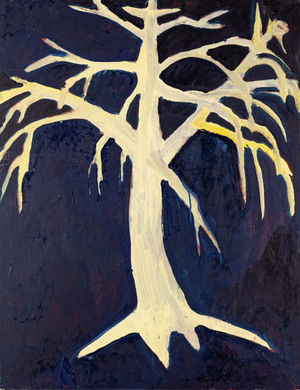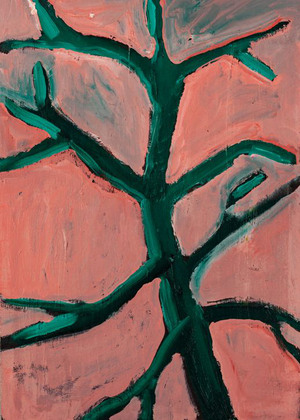Zardasht Faraj (1977)
Helvete, 2021
Zarathustra, 2021
Gråtande träd, 2021
Olja på pannå
Förvärvade till Ystads konstmuseums samling 2021


Helvete, Zarathustra och Gråtande träd ingår i en serie målningar som visades på Galleri Ping-Pong i Malmö 2021 och som alla föreställer träd eller grenar. I sina tidigare utställningar har Zardasht Faraj främst presenterat abstrakt måleri där han genom geometriska färgfält undersökt seendets möjligheter och rumslig perception. Farajs tidigare verk knyter också an till idén om sakral geometri, det vill säga att vissa former och proportioner är heliga. Genom konsthistorien har sådana heliga former ofta kopplats till naturen.
I Helvete, Zarathustra och Gråtande träd fungerar trädet som en mer organisk form för ett fortsatt undersökande av måleriet som språk, inte minst för olika mentala tillstånd. Det kan också tolkas symboliskt. Verkens titlar refererar till idéer om gott och ont så kanske är det kunskapens träd, trädet som enligt bibelns skapelseberättelse ger kunskap om just gott och ont, som tar sig olika skepnader i Farajs målningar? Trädet är också en interkulturell symbol för liv.
Zardasht Faraj föddes i Bagdad 1977 och är verksam i Malmö. Mellan 2007-2012 studerade Faraj på Konsthögskolan i Malmö. Han har även gått på Skånska målarskolan och Östra Grevie Folkhögskola.
ENGLISH VERSION
Zardasht Faraj (b. 1977)
Hell, 2021
Zarathustra, 2021
Weeping Tree, 2021
Oil on panel
Acquired for Ystad Art Museum’s collection in 2021
Hell, Zarathustra and Weeping Tree are all part of a series of paintings that were shown at Galleri Ping-Pong in Malmö in 2021, all of which are representations of trees or branches. In his earlier exhibitions, Zardasht Faraj has primarily shown abstract paintings in which he used geometric colour fields to explore the potential in seeing and spatial perception. Faraj’s prior work also ties in with the idea of sacred geometry – that certain forms and proportions are holy. Throughout the history of art, such sacred forms have often been linked with nature.
In Hell, Zarathustra and Weeping Tree, the tree serves as a more organic form for the artist’s continued investigation of painting as a language, particularly for various states of mind. It can also be interpreted symbolically. The titles of the pieces refer to ideas of good and evil, so could it be that this is the tree of knowledge, which in the story of creation in the Bible gives Adam and Eve knowledge of good and evil, appearing in different forms in Faraj’s paintings? The tree is also an inter-cultural symbol of life.
Zardasht Faraj was born in Baghdad in 1977 and now works in Malmö. Between 2007 and 2012, he studied at the Malmö Art Academy. He also attended the Scanian School of Painting and Östra Grevie Community College.
Text: Ellen Klintenberg
Publicerad 2022-02-08, Uppdaterad 2023-11-24